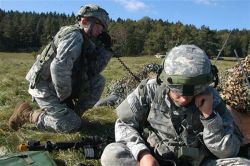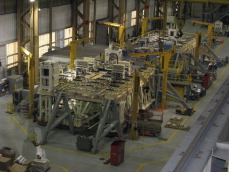STUTTGART, Germany , May 7, 2012 — With major force changes to unfold across Europe, including a drawdown of about 7,000 U.S. forces there, U.S. European Command remains committed to its mission of ensuring a ready force prepared to respond if called upon, officials said.
About 80,000 military forces based in Europe remain the command’s No. 1 tool both for maintaining U.S. influence across the theater and, when called upon, for projecting power within and beyond it, Navy Adm. James G. Stavridis, the Eucom commander, told Congress in March. They represent “a visible and incontestable manifestation of U.S. commitment to the region” as they engage with regional allies and partners to ensure their mutual readiness and ability to work together, he said.
President Barack Obama’s strategic guidance that looks out over the next 10 years calls for reducing the U.S. presence in Europe by about 15 percent, to 68,000 troops. The plan, which affects U.S. European Command and its Army, Navy, Air Force and Marine Corps components, calls for inactivating:
- The 170th and 172nd Infantry brigades, two of the four brigade combat teams in Europe, by fiscal 2014;
- The Air Force’s 81st Fighter Squadron with its A‑10 aircraft at Spangdahlem Air Base, Germany, during fiscal year 2013;
- The 603rd Air Control Squadron at Aviano Air Base, Italy, in fiscal year 2013; and
- 5th Corps Headquarters in Wiesbaden, Germany, to become the new home of U.S. Army Europe headquarters, now in Heidelberg, Germany.
In addition, U.S. Army Europe will cut about 2,500 soldiers assigned to enabling units over the next five years.
But, as Eucom officials are quick to note, the strategic guidance isn’t all about cuts.
In addition to preserving two heavy brigades the 173rd Airborne Brigade Combat Team to be consolidated in Vicenza, Italy, and 2nd Stryker Cavalry Regiment at Vilseck, Germany — it proposes additions that enhance capability. These include:
- A rotational U.S.-based heavy brigade combat team to support the NATO Response Force;
- A battalion-size element from the rotational brigade to participate in joint exercises and operations;
- Four ballistic missile defense-capable destroyers to be home-ported in Rota, Spain;
- A squadron of new V‑22 aircraft to be based in Europe to support special operations;
- A small aviation detachment to be stood up in Poland to support rotational deployments of F‑16 and C‑130 units as they promote interoperability with Polish air forces;
- A ground-based radar in Turkey; and
- More Special Forces units stationed in Germany.
Looking at this big-picture plan that he worked on with Defense Secretary Leon E. Panetta and Chairman of the Joint Chiefs of Staff Gen. Martin E. Dempsey, Stavridis said he’s satisfied it postures Eucom for what’s ahead.
“I think we are adjusting our force appropriately to support this new strategy,” he said. “We will continue to have an important and enduring mission in the European theater for many years to come.”
Navy Vice Adm. Charles Martoglio, Stavridis’ former chief of staff and now deputy commander, said it all boils down to having what’s needed to accomplish the mission in the most efficient and effective manner.
“Ensuring that we have the right capabilities at the right level of readiness in the right places to match the security environment that we see emerging is one of the big responsibilities of U.S. European Command,” he said.
Navy Rear Adm. Mark Montgomery, Eucom’s deputy director for plans, policy and strategy, said the capability that will reside within the command following these force changes is so striking that he shuns using the term “drawdown” to describe it.
“We’ve decided to strategically rebalance our forces,” he said. “What that means is we have increased our forces in the ballistic missile area. We’ve increased our forces in the maritime domain. We’ve increased our Special Forces here in Europe, and we have reduced our forces who do general-purpose ground fighting.”
Montgomery noted that for the past decade, two of Eucom’s four brigades have been in a continual process of preparing for, deploying or resetting after deployments to Iraq or Afghanistan. “So of four brigades, you would have about two brigades” to be available for other missions, he said.
“And that is what we are going to end up with in 2016,” he said. “We are going to have two brigades that are uniquely skilled and will look like many of our European partners’ units: an airborne brigade and a Stryker brigade.”
The result, he said, will be “the right number to get at the mission we are going to be assigned in 2016,” he said. “So in my mind, this is a strategic rebalancing and not a reduction or some kind of move away from Europe. In no way, shape or form do I see that.”
Stavridis told Congress the new rotational brigade combat team in Europe will go a long way to mitigate the loss of two permanent ones. “Instead of being a static BCT essentially parked in Germany, this would be a BCT that could rotate its battalions one time into Eastern Europe, one time into the Balkans, one time into the Baltics, as well as other places that U.S. European Command might be asked to operate,” he said.
In addition, he said the four ships to be home-ported in Spain will bring multiple capabilities to the theater. In addition to ballistic missile defense, they will be able to support anti-submarine and anti-surface ship operations, to gather intelligence or to deploy the highly sophisticated aircraft attached to them.
“So the capability that you bring forward into this theater is, frankly, profound,” he said. “For every ship that is forward-deployed, it’s really the equivalent of the effort of three or four ships back in the United States because of the transit time.”
In reality, the reductions taking place are part of a process that’s been ongoing for the past 20 years, Stavridis explained during an interview with the Pentagon Channel and American Forces Press Service. He noted that during the Cold War, the United States had almost 400,000 forces in Europe, operating at some 1,200 bases and focused on the Warsaw Pact threat.
With that force already down by 75 percent, Stavridis called the additional 15 percent reductions planned manageable and appropriate when viewed through the new global context. “That’s a pretty reasonable and sensible reduction, given the reduced threat,” he said.
Although the new strategic guidance focuses predominantly on challenges in the Asia-Pacific region and the Middle East, Stavridis said there’s no question that the strategic partnerships within the European theater will play prominently in its success.
“Let’s face it: Our most enduring pool of partners exists in the European theater,” he said. Most notable are the 28 NATO members that collectively have 3 million men and women under arms, 24,000 aircraft and some 800 ships.
“This is an alliance of enormous resource, and it represents those that stand with us today in Afghanistan, in the Balkans, in the Libyan operation, in [counterpiracy],” he said. “So these strategic, enduring partnerships in Europe are going to underpin the strategic focus on challenges in Asia and in the Middle East.”
Source:
U.S. Department of Defense
Office of the Assistant Secretary of Defense (Public Affairs)

 von
von 
